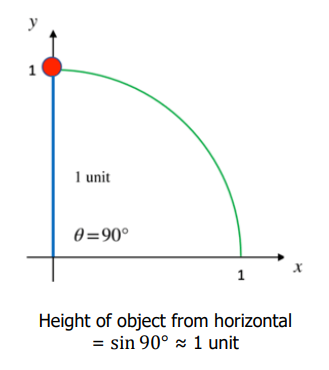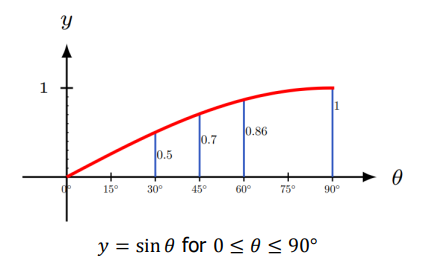5.3: Graphs of the Sine Function
- Page ID
- 125052
\( \newcommand{\vecs}[1]{\overset { \scriptstyle \rightharpoonup} {\mathbf{#1}} } \)
\( \newcommand{\vecd}[1]{\overset{-\!-\!\rightharpoonup}{\vphantom{a}\smash {#1}}} \)
\( \newcommand{\id}{\mathrm{id}}\) \( \newcommand{\Span}{\mathrm{span}}\)
( \newcommand{\kernel}{\mathrm{null}\,}\) \( \newcommand{\range}{\mathrm{range}\,}\)
\( \newcommand{\RealPart}{\mathrm{Re}}\) \( \newcommand{\ImaginaryPart}{\mathrm{Im}}\)
\( \newcommand{\Argument}{\mathrm{Arg}}\) \( \newcommand{\norm}[1]{\| #1 \|}\)
\( \newcommand{\inner}[2]{\langle #1, #2 \rangle}\)
\( \newcommand{\Span}{\mathrm{span}}\)
\( \newcommand{\id}{\mathrm{id}}\)
\( \newcommand{\Span}{\mathrm{span}}\)
\( \newcommand{\kernel}{\mathrm{null}\,}\)
\( \newcommand{\range}{\mathrm{range}\,}\)
\( \newcommand{\RealPart}{\mathrm{Re}}\)
\( \newcommand{\ImaginaryPart}{\mathrm{Im}}\)
\( \newcommand{\Argument}{\mathrm{Arg}}\)
\( \newcommand{\norm}[1]{\| #1 \|}\)
\( \newcommand{\inner}[2]{\langle #1, #2 \rangle}\)
\( \newcommand{\Span}{\mathrm{span}}\) \( \newcommand{\AA}{\unicode[.8,0]{x212B}}\)
\( \newcommand{\vectorA}[1]{\vec{#1}} % arrow\)
\( \newcommand{\vectorAt}[1]{\vec{\text{#1}}} % arrow\)
\( \newcommand{\vectorB}[1]{\overset { \scriptstyle \rightharpoonup} {\mathbf{#1}} } \)
\( \newcommand{\vectorC}[1]{\textbf{#1}} \)
\( \newcommand{\vectorD}[1]{\overrightarrow{#1}} \)
\( \newcommand{\vectorDt}[1]{\overrightarrow{\text{#1}}} \)
\( \newcommand{\vectE}[1]{\overset{-\!-\!\rightharpoonup}{\vphantom{a}\smash{\mathbf {#1}}}} \)
\( \newcommand{\vecs}[1]{\overset { \scriptstyle \rightharpoonup} {\mathbf{#1}} } \)
\( \newcommand{\vecd}[1]{\overset{-\!-\!\rightharpoonup}{\vphantom{a}\smash {#1}}} \)
Discrete Graph of the Sine Function from 0° to 90°
The graph of the sine function gives a visual illustration of how it determines the height of an object from a horizontal axis.
Imagine an object moving counterclockwise along the circumference of the unit circle. Start the object’s motion at the point (1,0), then measure its height from the horizontal axis as its angle from origin increases from 0° to 90°.


Graphs of the Heights
If the angle is between 0° and 90°, the graph of the heights looks like this

We can see that from 0° and 90°, as the angle from the observer to the object increases, the height of the object from the horizontal increases. That is, the object moves vertically upward.
If the angle goes past 90°, say all the way to 180°, the graph of the heights looks like this

The object moves vertically upward, then vertically downward.
The Continuous Sine Curve from 0° to 90°
If we plotted all the heights for all the infinitely many angles between 0° and 90°, we would get this continuous graph

The Continuous Sine Curve from 0° to 180°
If we plotted all the heights for all the angles between 0° and 180°, we would get the continuous graph below

The Continuous Sine Curve from 0° to 360°
If we were to let the object travel all the way around the circle, we get the graph of the sine curve from 0° to 360°. You can see that when the angle \(\theta\) is between 180° and 360°, the object is below the horizontal and may not be visible to an observer.

The Extended Sine Curve
If we were to let the object keep travelling around the circle, we would see that the height of the curve just oscillates between –1 and 1.

It may now be visually apparent that
The sine function controls the vertical distance of an object above or below the horizontal.
What to See
The graph shows how an object’s vertical distance from the horizontal changes as the angle of view increases. As the angle of view increases, the vertical distance from the horizontal increases and decreases.
What Not to See
The graph does not show how an object moves horizontally as the angle of view increases. The object is not moving up and down horizontally along the curve as time goes by. The horizontal axis is the angle of view, not time.
Try these
An object moves along the circumference of a unit circle. Find its height from the horizontal if the angle it makes from the origin is
- 225°
- 270°
- 315°
- 360°
- Answer
-
- -0.7071
- -1
- -0.7071
- 0
An object moves along the circumference of a unit circle. Find its height from the horizontal if the angle it makes from the origin is
- 390°
- 405°
- 420°
- 450°
- Answer
-
- 0.5
- 0.7071
- 0.8660
- 1
Determine if each statement is true or false.
- Height at 87° > height at 78°
- Height at 155° > height at 145°
- Height at 30° ≥ height at 150°
- Height at 90° ≥ height at 270°
- Answer
-
- True, since 0.9986 \(\mathrm{>}\) 0.9781
- False, since 0.4226 \(\mathrm{<}\) 0.5736
- True, since 0.5 = 0.5
- True, since \(1\ge -1\)
Keeping in mind that the sine function determines vertical distance, and the cosine function determines horizontal distance, determine if each statement is true or false. The observer is at the origin.
- Vertical height at 87° > horizontal distance at 87°
- Vertical height at 155° > horizontal distance at 55°
- Vertical height at 20° < horizontal distance at 20°
- Vertical height at 135° = horizontal distance at 315°
- Answer
-
- True, since \({\mathrm{sin} (87{}^\circ )=0.9986>\ {\mathrm{cos} (87{}^\circ )=0.0523\ }\ }\)
- False, since \({\mathrm{sin} (155{}^\circ )=0.4226<\ {\mathrm{cos} (55{}^\circ )=0.5736\ }\ }\)
- True, since \({\mathrm{sin} (20{}^\circ )=0.3420<\ {\mathrm{cos} (20{}^\circ )=0.9396\ }\ }\)
- True, since \({\mathrm{sin} (135{}^\circ )=0.7071=\ {\mathrm{cos} (315{}^\circ )=0.7071\ }\ }\)

